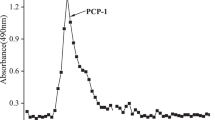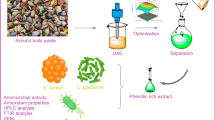Abstract
Olive mill wastewater (OMWW), the main waste product of olive oil extraction process, was investigated as a source of polysaccharides. The yield of alcohol insoluble residue (AIR) was 20.5 % based on the dry matter of OMWW. Extraction with water gave water soluble (WSF) and insoluble (WIF) fractions from AIR with yields of 13.3 % (w/w) and 3.7 % (w/w) based on the dry matter, respectively. Chemical composition and monosaccharide analysis indicated that glucose was the main monosaccharide of these extracts in addition to galactose, arabinose, rhamnose, and galacturonic acid. Prebiotic and antioxidant activities of polysaccharidic fractions from OMWW were evaluated. Results gave evidence for their scavenging capacity toward the 2,2′-diphenyl-1-picrylhydrazyle (DPPH) (IC50 value of 89.43 μg/mL) and hydroxyl radicals (IC50 value of 158.70 μg/mL), resistance toward artificial human gastric juice, and ability to be fermented by Lactobacilli strains.



Similar content being viewed by others
References
Dermeche, S., Nadour, M., Larroche, C., Moulti-Mati, F., & Michaud, P. (2013). Olive mill wastes: biochemical characterizations and valorization strategies. Process Biochemistry, 48, 1532–1552.
Roig, A., Cayuela, M. L., & Sanchez-Monedero, M. A. (2006). An overview on olive mill wastes and their valorization methods. Waste Management, 26, 960–969.
Ramos, P., Santos, S. A. O., Guerra, A. R., Guerreiro, O., Felício, L., Jerónimo, E., Silvestre, A. J. D., Neto, C. P., & Duarte, M. (2013). Valorization of olive mill residues: antioxidant and breast cancer antiproliferative, activities of hydroxytyrosol-rich extracts derived from olive oil by-products. Industrial Crops and Products, 46, 359–368.
Kessler, B., Weusthuis, R., Witholt, B., & Eggink, G. (2001). Production of microbial polyesters: fermentation and downstream processes. Advances in Biochemical Engineering/Biotechnology, 71, 159–182.
Eroglu, E., Gunduz, U., Yucel, M., Turker, L., & Eroglu, I. (2004). Photobiological hydrogen production by using olive mill wastewater as a sole substrate source. International Journal of Hydrogen Energy, 29(2), 163–171.
Zenjari, B., El Hajjouji, H., Ait Baddi, G., Bailly, J. R., Revel, J. C., Nejmeddine, A., & Hafidi, M. (2006). Eliminating toxic compounds by composting olive mill wastewater-straw mixtures. Journal of Hazardous Materials, 138(3), 433–437.
López, M. J., Moreno, J., & Ramos-Cormenzana, A. (2001). Xanthomonas campestris strain selection for xanthan production from olive mill wastewaters. Water Research, 35, 1828–1830.
Coimbra, M. A., Waldron, K. W., & Selvendran, R. R. (1994). Isolation and characterization of cell wall polymers from olive pulp (Olea europea L.). Carbohydrate Research, 252, 245–262.
Jiménez, A., Guillén, R., Fernández-Bolaños, J., & Heredia, A. (1994). Cell wall composition of olives. Journal of Food Science, 59, 1192–1196.
Coimbra, M. A., Barros, A., Rutledge, D. N., & Delgadillo, I. (1999). FTIR spectroscopy as a tool for the analysis of olive pulp cell-wall polysaccharide extracts. Carbohydrate Research, 317, 145–154.
Vierhuis, E., Schols, H. A., Beldman, G., & Voragen, A. G. J. (2001). Structural characterization of xyloglucan and xylans present in olive fruit (Olea europaea cv koroneiki). Carbohydrate Polymers, 44, 51–62.
Vierhuis, E., Korver, M., Schols, H. A., & Voragen, A. G. J. (2003). Structural characteristics of pectic polysaccharides from olive fruit (Olea europaea cv moraiolo) in relation to processing for oil extraction. Carbohydrate Polymers, 51, 135–148.
Galanakis, C. M., Tornberg, E., & Gekas, V. (2010). A study of the recovery of the dietary fibres from olive mill wastewater and the gelling ability of the soluble fibre fraction. LWT- Food Science and Technology, 43, 1009–1017.
Sawabe, Y., Nakagomi, K., Iwagami, S., Suzuki, S., & Nakazawa, H. (1992). Inhibitory effects of pectic substances on activated hyaluronidase and histamine release from mast cells. Biochimica et Biophysica Acta, 1137, 274–278.
Nergard, C. S., Matsumoto, T., Inngjerdingen, M., Inngjerdingen, K., Hokputsa, S., Harding, S. E., Michaelsen, T. E., Diallo, D., Kiyohara, H., Paulsen, B. S., & Yamada, H. (2005). Structural and immunological studies of a pectin and a pecticarabinogalactan from Vernonia kotschyana Sch. Bip. exWalp. (Asteraceae). Carbohydrate Research, 340, 115–130.
Brouns, F., Theuwissen, E., Adam, A., Bel, M., Berger, A., & Mensink, R. P. (2012). Cholesterol-lowering properties of different pectin types in mildly hypercholesterolemic men and women. European Journal of Clinical Nutrition, 66(5), 591–599.
Inngjerdingen, K. T., Thöle, C., Diallo, D., Paulsen, B. S., & Hensel, A. (2014). Inhibition of Helicobacter pylori adhesion to human gastric adenocarcinoma epithelial cells by aqueous extracts and pectic polysaccharides from the roots of Cochlospermum tinctorium A. Rich. and Vernonia kotschyana Sch. Bip. ex Walp. Fitoterapia, 95, 127–132.
Torralbo, D. F., Batista, K. A., Di-Medeiros, M. C. B., & Fernandes, K. F. (2012). Extraction and partial characterization of Solanum lycocarpum pectin. Food Hydrocolloids, 27, 378–383.
Cárdenas, A., Goycoolea, F. M., & Rinaudo, M. (2008). On the gelling behaviour of ‘nopal’ (Opuntia ficus indica) low methoxyl pectin. Carbohydrate Polymers, 73, 212–222.
Tamaki, Y., Konishi, T., Fukuta, M., & Tako, M. (2008). Isolation and structural characterisation of pectin from endocarp of Citrus depressa. Food Chemistry, 107, 352–361.
Posé, S., Kirby, A. R., Mercado, J. A., Morris, V. J., & Quesada, M. A. (2012). Structural characterization of cell wall pectin fractions in ripe strawberry fruits using AFM. Carbohydrate Polymers, 88, 882–890.
Douillard, F. P., Ribbera, A., Järvinen, H. M., Kant, R., Pietilä, T. E., Randazzo, C., Paulin, L., Laine, P. K., Caggia, C., von Ossowski, I., Reunanen, J., Satokari, R., Salminen, S., Palva, A., & de Vos, W. M. (2013). Comparative genomic and functional analysis of Lactobacillus casei and Lactobacillus rhamnosus strains marketed as probiotics. Applied and Environmental Microbiology, 79, 1923–1933.
Monsigny, M., Petit, C., & Roche, A. C. (1988). Colorimetric determination of neutral sugars by a resorcinol sulphuric acid micro-method. Analytical Biochemistry, 175, 525–530.
Blumenkrantz, N., & Asboe-Hansen, G. (1973). New method for quantitative determination of uronic acids. Analytical Biochemistry, 54, 484–489.
Waffenschmidt, S., & Jaenicke, L. (1987). Assay of reducing sugars in the nanomole range with 2,2'-bicinchininate. Analytical Biochemistry, 165, 337–340.
Bradford, H. M. (1976). A rapid and sensitive method for quantification of microgram quantities of protein utilizing the principle of protein-dye binding. Analytical Biochemistry, 72, 248–254.
Hach, C. C., Brayton, S. V., & Kopelove, A. B. (1985). A powerful Kjeldahl nitrogen method using peroxymonosulfuric acid. Journal of Agricultural and Food Chemistry, 33, 1117–1123.
Gutfinger, J. (1981). Polyphenols in olive oils. Journal of the American Chemical Society, 58, 966–968.
Delattre, C., Pierre, G., Gardarin, C., Traikia, M., Elboutachfaiti, R., Isogai, A., & Michaud, P. (2015). Antioxidant activities of a polyglucuronic acid sodium salt obtained from TEMPO-mediated oxidation of xanthan. Carbohydrate Polymers, 116, 34–41.
Korakli, M., Ganzle, M. G., & Vogel, R. F. (2002). Metabolism by bifidobacteria and lactic acid bacteria of polysaccharides from wheat and rye, and exopolysaccharides produced by Lactobacillus sanfranciscensis. Journal of Applied Microbiology, 92, 958–965.
Vierhuis, E., Schols, H. A., Beldman, G., & Voragen, A. G. J. (2000). Isolation and characterization of cell wall material from olive fruit (Olea europaea cv koroneiki) at different ripening stages. Carbohydrate Polymers, 44, 51–62.
Huisman, M. M. H., Schols, H. A., & Voragen, A. G. J. (1996). Changes in cell wall polysaccharides from ripening olive fruits. Carbohydrate Polymers, 31, 123–133.
Cardoso, S. M., Coimbra, M. A., & Lopez da Silva, J. A. (2003). Calcium-mediated gelation of an olive pomace extract. Carbohydrate Polymers, 52, 125–133.
Ralet, M. C., Thibault, J. F., Faulds, C. B., & Williamson, G. (1994). Isolation and purification of feruloylated oligosaccharides from cell-walls of sugar-beet pulp. Carbohydrate Research, 263, 227–241.
Buanafina, O. (2009). Feruloylation in grasses: current and future perspectives. Molecular Plant, 2(5), 861–872.
Ralet, M. C., André-Leroux, G., Quéméner, B., & Thibault, J. F. (2005). Sugar beet (Beta vulgaris) pectins are covalently cross-linked through diferulic bridges in the cell wall. Phytochemistry, 66, 2800–2814.
Cardoso, S. M., Mafra, I., Reis, A., Nunes, C., Saraiva, J. A., & Coimbra, M. A. (2010). Naturally fermented black olives: effect on cell wall polysaccharides and on enzyme activities of Taggiasca and Conservolea varieties. LWT- Food Science and Technology, 43, 153–160.
Coimbra, M. A., Barros, A., Barros, M., Rutledge, D. N., & Delgadillo, I. (1998). FTIR spectroscopy as a tool for the analysis of olive pulp cell-wall polysaccharide extracts. Carbohydrate Polymers, 37, 241–248.
Jiménez, A., Rodríguez, R., Fernández-Caro, I., Guillén, R., Fernández-Bolanõs, J., & Heredia, A. (2001). Olive fruit cell wall: degradation of pectic polysaccharides during ripening. Journal of Agricultural and Food Chemistry, 49, 409–415.
Araujo, A. J., Labavitch, J. M., & Moreno, A. H. (1994). Changes in the cell wall of olive fruit during processing. Journal of Agricultural and Food Chemistry, 42, 1194–1199.
Selvendran, R. R., & O’Neil, M. A. (1987). Isolation and analysis of cell walls from plant material. Methods of Biochemical Analysis, 32, 25–153.
Hayashi, T. (1989). Xyloglucans in the primary cell wall. Annual Review of Plant Physiology, 40, 139–168.
Rollet-Labelle, E., Grange, M. J., Elbim, C., Marquetty, C., Gougerot-Pocidalo, M. A., & Pasquier, C. (1998). Hydroxyl radical as a potential intracellular mediator of polymorphonuclear neutrophil apoptosis. Free Radical Biology & Medicine, 24, 563–572.
Xu, R., Ye, H., Sun, Y., Tu, Y., & Zeng, X. (2012). Preparation, preliminary characterization, antioxidant, hepatoprotective and antitumor activities of polysaccharides from the flower of tea plant (Camellia sinensis). Food and Chemical Toxicology, 50, 2473–2480.
Aruoma, O. I. (1998). Free radicals oxidative stress and antioxidants in human health and disease. Journal of the American Oil Chemists' Society, 78, 199–211.
Luo, A. X., He, X. J., Zhou, S. D., Fan, Y. J., Luo, A. S., & Chun, Z. (2010). Purification, composition analysis and antioxidant activity of the polysaccharides from Dendrobium nobile Lindl. Carbohydrate Polymers, 79, 1014–1019.
Wu, G. H., Hu, T., Li, Z. Y., Huang, Z. L., & Jiang, J. G. (2014). In vitro antioxidant activities of the polysaccharides from Pleurotus tuber-regium (Fr.) Sing. Food Chemistry, 148, 351–356.
Boual, Z., Pierre, G., Delattre, C., Benaoun, F., Petit, E., Gardarin, C., Michaud, P., & Didi Ould El Hadj, M. (2015). Mediterranean semi-arid plant Astragalus armatus as source of bioactive galactomannan. Bioactive Carbohydrates and Dietary Fibre, 5, 10–18.
Wong, S. P., Leong, L. P., & Koh, J. H. W. (2006). Antioxidant activities of aqueous extracts of selected plants. Food Chemistry, 99, 775–783.
Chen, H., Zhang, M., Qu, Z., & Xie, B. (2008). Antioxidant activities of different fractions of polysaccharide conjugates from green tea (Camellia Sinensis). Food Chemistry, 106, 559–563.
Han, Q., Yu, Q., Shi, J., Xiong, C., Ling, Z., & He, P. (2011). Structural characterization and antioxidant activities of 2 water-soluble polysaccharide fractions purified from tea (Camellia sinensis) flower. Journal of Food Science, 76, C462–C471.
Zeng, W. C., Zhang, Z., Gao, H., Jia, L. R., & Chen, W. Y. (2012). Characterization of antioxidant polysaccharides from Auricularia auricular using microwave-assisted extraction. Carbohydrate Polymers, 89, 694–700.
Gibson, G. R., & Roberfroid, M. B. (1995). Dietary modulation of the human colonic microbiota: introducing the concept of prebiotics. Journal of Nutrition, 125, 1401–1412.
Wang, Y. (2009). Prebiotics: present and future in food science and technology. Food Research International, 42, 8–12.
Wichienchot, S., Jatupornpipat, M., & Rastall, R. A. (2010). Oligosaccharides of pitaya (dragon fruit) flesh and their prebiotic properties. Food Chemistry, 120, 850–857.
Doron, S., Snydman, D. R., & Gorbach, S. L. (2005). Lactobacillus GG: bacteriology and clinical applications. Gastroenterology Clinics of North America, 34, 483–498.
Vernazza, C. L., Gibson, G. R., & Rastall, R. A. (2006). Carbohydrate preference, acid tolerance and bile tolerance in five strains of Bifidobacterium. Journal of Applied Microbiology, 100, 846–853.
Ramnani, P., Chitarrari, R., Tuohy, K., Grant, J., Hotchkiss, S., Philp, K., Campbell, R., Gill, C., & Rowland, I. (2012). In vitro fermentation and prebiotic potential of novel low molecular weight polysaccharides derived from agar and alginate seaweeds. Anaerobe, 18, 1–6.
López-Molina, D., Navarro-Martĺnez, M. D., Melgarejo, F. R., Hiner, A. N. P., Chazarra, S., & Rodrĺguez-López, J. N. (2005). Molecular properties and prebiotic effect of inulin obtained from artichoke (CynarascolymusL.). Phytochemistry, 66, 1476–1484.
Acknowledgments
This study was supported by the “Partenariat Hubert Curien TASSILI (EGIDE).”
Author information
Authors and Affiliations
Corresponding author
Rights and permissions
About this article
Cite this article
Nadour, M., Laroche, C., Pierre, G. et al. Structural Characterization and Biological Activities of Polysaccharides from Olive Mill Wastewater. Appl Biochem Biotechnol 177, 431–445 (2015). https://doi.org/10.1007/s12010-015-1753-5
Received:
Accepted:
Published:
Issue Date:
DOI: https://doi.org/10.1007/s12010-015-1753-5




